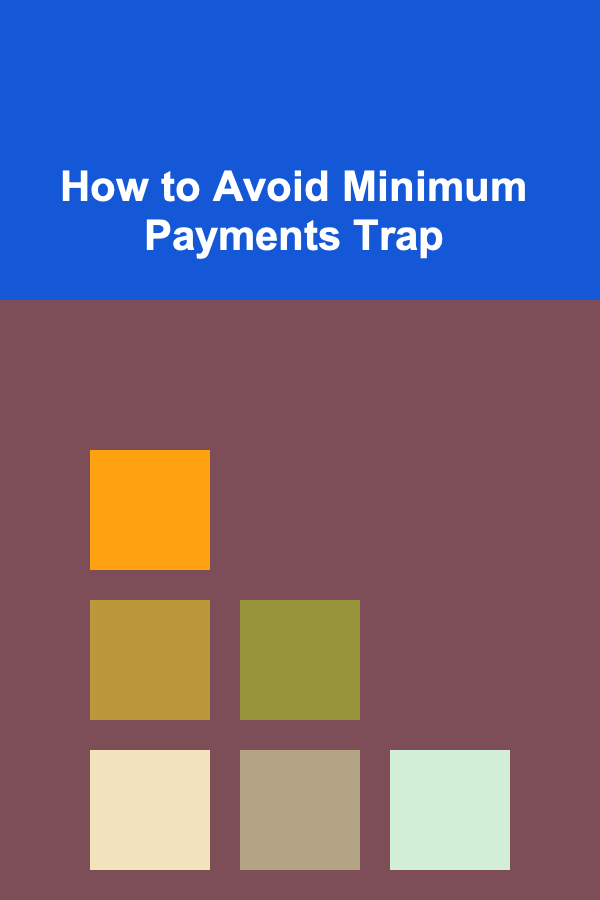
How to Avoid Minimum Payments Trap
ebook include PDF & Audio bundle (Micro Guide)
$12.99$5.99
Limited Time Offer! Order within the next:

Managing credit card debt effectively is a crucial aspect of maintaining financial health. Many people fall into the minimum payments trap, a situation where individuals only make the minimum required payment on their credit cards, leading to long-term financial struggles and paying much more in interest over time. Understanding how this trap works and how to avoid it can make a significant difference in your financial future.
This article will explore the concept of the minimum payments trap, the dangers it poses, and strategies for avoiding it. By making informed decisions, you can avoid sinking deeper into debt and work toward achieving financial freedom.
What is the Minimum Payments Trap?
The Basics of Minimum Payments
Credit card issuers often require a minimum payment, which is a small portion of your total balance, typically between 2% and 4% of your outstanding balance. This minimum amount covers interest charges and a small portion of the principal, ensuring that the balance doesn't grow exponentially in a short period.
For example, if you have a balance of $2,000 on a credit card with a 20% annual interest rate, the minimum payment might be around $40--$80 each month. Although this may seem like a manageable amount, it is often not enough to make a substantial dent in the debt. Most of the payment will go toward covering interest charges, and only a tiny portion will reduce the principal balance.
Why is It Dangerous?
The minimum payment is designed to make it easier for individuals to keep up with their credit card debt, but it can lead to several long-term problems:
- Long-Term Debt: Making only minimum payments results in a cycle of debt that can last for many years. For large balances, it may take decades to pay off the debt entirely, especially when only a small portion of the payment goes toward the principal.
- High Interest Payments: Credit card companies charge interest on the remaining balance, and when you're only paying the minimum, interest accumulates quickly. As a result, you may end up paying much more in interest than you originally borrowed.
- Reduced Credit Score: Carrying a large balance on your credit card can negatively affect your credit utilization ratio, which is a significant factor in determining your credit score. If you consistently only make the minimum payment, your credit score can suffer, making it harder to secure favorable loan terms or other credit opportunities.
How the Minimum Payments Trap Works
Credit card companies often structure their payment terms in a way that encourages customers to make minimum payments. This creates a situation where, although it feels like you're making progress, you're not actually reducing your debt in a meaningful way. Here's how the minimum payments trap works:
- Slow Progress on Principal: When you make the minimum payment, most of your payment goes toward paying off the interest, with a small amount applied to the principal. This means that your outstanding balance decreases slowly, if at all. The debt keeps growing because the interest compounds monthly, adding to the balance.
- High Interest Rates: Credit cards typically have higher interest rates compared to other forms of debt. If you carry a balance, you'll end up paying more in interest over time. The longer you take to pay off the debt, the more interest you'll owe, making it much more expensive in the long run.
- Minimum Payment vs. Total Balance: On a large balance, the minimum payment may feel like a manageable amount, but the reality is that it may take years to pay off even a modest balance if you only make the minimum payment. This can result in the debt hanging over you for a very long time, with the burden of interest charges making it even harder to escape.
For example, let's consider a $5,000 credit card balance with an interest rate of 18%. If you only make the minimum payment of 3% per month (around $150), it will take approximately 20 years to pay off the debt, and you will end up paying over $10,000 in total --- more than double the original debt.
Strategies for Avoiding the Minimum Payments Trap
Avoiding the minimum payments trap requires a strategic approach to managing your credit card debt. Below are several effective strategies to help you break free from this cycle and regain control over your finances.
1. Pay More Than the Minimum
The most effective way to avoid the minimum payment trap is to always pay more than the minimum required amount. Even an extra $50 to $100 per month can significantly reduce the time it takes to pay off your balance and the amount of interest you'll end up paying.
By paying more than the minimum, you reduce the principal balance faster, which in turn reduces the interest charges. This is the most direct way to accelerate your debt repayment and avoid paying excessive amounts in interest over time.
2. Create a Debt Repayment Plan
A structured debt repayment plan is essential for staying on track. There are several approaches you can take:
- The Debt Snowball Method: This strategy involves paying off your smallest debt first while making minimum payments on larger debts. Once the smallest debt is paid off, you move on to the next smallest debt, and so on. This method provides psychological benefits, as it allows you to see quick progress.
- The Debt Avalanche Method: In this method, you focus on paying off the debt with the highest interest rate first, while making minimum payments on others. This approach saves you the most money in interest over time but may not provide the same immediate satisfaction as the snowball method.
Choose the method that works best for you, and stick to your plan to make steady progress in paying off your credit card debt.
3. Consider a Balance Transfer
If you're struggling with high interest rates, a balance transfer could be a useful tool to help you pay off your debt faster. Many credit card companies offer promotional interest rates (often 0%) for balance transfers, which can significantly reduce the amount you pay in interest.
By transferring your balance to a card with a lower interest rate, you can allocate more of your payment toward reducing the principal balance. However, balance transfers usually come with fees, so it's important to read the terms carefully before proceeding.
4. Cut Back on Spending
A significant aspect of breaking free from credit card debt is changing your spending habits. If you're relying on credit cards for purchases, it's time to reassess your spending patterns. Consider these steps to reduce unnecessary spending:
- Create a budget: Track your expenses and identify areas where you can cut back. Allocate any savings toward paying down your credit card debt.
- Limit credit card use: Use cash or debit cards for purchases to avoid adding to your credit card debt.
- Prioritize debt repayment: If possible, direct any extra funds toward paying off your credit card debt, especially if you receive a windfall, such as a tax refund or bonus.
5. Consolidate Your Debt
If you have multiple credit cards with high interest rates, consolidating your debt into a single loan with a lower interest rate may be an effective strategy. Debt consolidation can simplify your finances by combining all your balances into one payment and potentially lowering your interest rate.
Options for debt consolidation include personal loans, home equity loans, and debt consolidation loans. Make sure to shop around for the best rates and terms to avoid getting locked into unfavorable conditions.
6. Negotiate With Creditors
If you're struggling to keep up with your minimum payments, don't hesitate to reach out to your credit card issuer. Many creditors are willing to negotiate with you to create a more manageable repayment plan. Some strategies include:
- Request a lower interest rate: If you've been a loyal customer, you may be able to negotiate a lower interest rate, which will help reduce the amount of interest you pay on your balance.
- Ask for a payment plan: Some credit card companies offer hardship programs that allow you to make reduced payments for a period, or even temporarily freeze interest charges, in times of financial difficulty.
- Explore debt settlement: In extreme cases, negotiating a settlement with your creditor can reduce the total amount of debt you owe, but this can have significant consequences on your credit score.
7. Build an Emergency Fund
Having an emergency fund can help prevent you from relying on credit cards in case of unforeseen expenses. By building an emergency fund, you can avoid turning to credit cards when you experience unexpected costs, which can prevent further debt accumulation.
Aim to save at least three to six months' worth of living expenses in a liquid, easily accessible account, such as a high-yield savings account, to protect yourself from the temptation to carry a balance on your credit cards.
Conclusion
The minimum payments trap can be a major obstacle on the path to financial freedom, but with the right strategies and discipline, it is avoidable. Paying more than the minimum, creating a structured repayment plan, cutting back on unnecessary spending, and consolidating your debt are all effective ways to escape the trap. Taking control of your credit card debt not only improves your financial health but also reduces stress and increases your ability to save and invest for the future.
By understanding how the minimum payments trap works and taking steps to break free from it, you can make significant progress in managing your finances and building a debt-free future.

How to Incorporate Trendy Decor Elements Without Breaking the Bank
Read More
How to Use Magnetic Strips for Small Spice Jars
Read More
Mastering Marketing Analysis: Essential Skills for Data-Driven Strategies
Read More
Monetize Your Deep Learning Skills: Build AI Products for Profit
Read More
Leveraging Social Media for Trend Spotting: A Comprehensive Guide
Read More
Choosing the Right Bearing Puller for Hub and Axle Work
Read MoreOther Products

How to Incorporate Trendy Decor Elements Without Breaking the Bank
Read More
How to Use Magnetic Strips for Small Spice Jars
Read More
Mastering Marketing Analysis: Essential Skills for Data-Driven Strategies
Read More
Monetize Your Deep Learning Skills: Build AI Products for Profit
Read More
Leveraging Social Media for Trend Spotting: A Comprehensive Guide
Read More